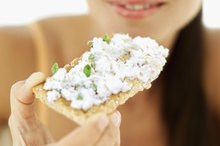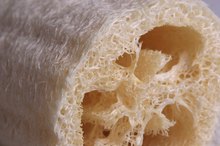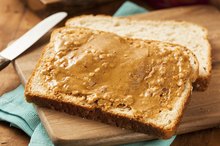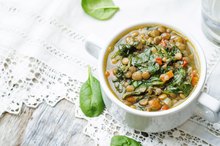What does fact checked mean?
At Healthfully, we strive to deliver objective content that is accurate and up-to-date. Our team periodically reviews articles in order to ensure content quality. The sources cited below consist of evidence from peer-reviewed journals, prominent medical organizations, academic associations, and government data.
- Academy of Nutrition and Dietetics: Fiber?
- Kids Eat Right: Portion Distortion
- Academy of Nutrition and Dietetics: Ways to Boost Fiber
The information contained on this site is for informational purposes only, and should not be used as a substitute for the advice of a professional health care provider. Please check with the appropriate physician regarding health questions and concerns. Although we strive to deliver accurate and up-to-date information, no guarantee to that effect is made.
Fiber Content of Peanut Butter
Slathered on a sandwich, as a dip for celery sticks or simply eaten with a spoon, peanut butter is a creamy spread loved by many. When it comes to fiber, peanut butter can contain as much fiber as the slice of bread it covers. Adding peanut butter to your diet can be a tasty and effective way to increase your fiber intake, any way you spread it.
Fiber Basics
Fiber is a key nutrient that plays an important role in regular digestion, and also in the prevention of certain diseases and health-related issues. Regular fiber intake can help prevent such conditions as heart disease, diabetes, weight gain and constipation. According to the Academy of Nutrition and Dietetics, men should aim to get 38 grams of fiber per day and women 25 grams per day. If you are over 50, the recommendations drop to 30 grams per day for men and 21 grams per day for women.
- Fiber is a key nutrient that plays an important role in regular digestion, and also in the prevention of certain diseases and health-related issues.
- According to the Academy of Nutrition and Dietetics, men should aim to get 38 grams of fiber per day and women 25 grams per day.
Fiber in Peanut Butter
Is Eating Cream Cheese & Crackers Healthy?
Learn More
Each tablespoon of smooth peanut butter contains 1 gram of fiber. The chunky kind contains 1.3 grams of fiber per tablespoon, or 30 percent more than the smooth variety. Pair the spread with other good sources of fiber, and those numbers can add up quickly. A slice of whole wheat bread contains 1.5 grams of fiber. Make a peanut butter sandwich with 2 tablespoons of chunky peanut butter for a total of 5.6 grams of fiber, or 15 percent to 22 percent of the daily recommendation.
- Each tablespoon of smooth peanut butter contains 1 gram of fiber.
- Make a peanut butter sandwich with 2 tablespoons of chunky peanut butter for a total of 5.6 grams of fiber, or 15 percent to 22 percent of the daily recommendation.
Portion Control
Peanut butter is a good source of fiber, but it is higher in calories and fat than other sources. One serving, or 2 tablespoons of peanut butter, contains 180 calories and 16 grams of fat. Keep portions in mind and account for the amount of calories and fat you are eating, which can add up quickly. A good rule to remember is that a serving of peanut butter is about the size of a ping pong ball.
- Peanut butter is a good source of fiber, but it is higher in calories and fat than other sources.
- One serving, or 2 tablespoons of peanut butter, contains 180 calories and 16 grams of fat.
Tips to Increase Fiber Intake
How to Get Rid of Pimples on My Inner Thigh
Learn More
Many foods are good sources of fiber, including fruits, vegetables and whole grains such as oatmeal and whole wheat bread. Pair these foods with peanut butter to increase the amount of fiber in your diet 2. Some examples are a sliced apple, carrot sticks or a slice of whole-wheat toast. Swap an afternoon snack for one of these foods and a tablespoon of peanut butter for a healthy source of fiber each day. When you increase the amount of fiber in your diet, you also need to increase your fluid intake. Similar to a sponge, fiber needs to soak up a lot of fluid to help with regular digestion and prevent issues such as constipation or nausea.
- Many foods are good sources of fiber, including fruits, vegetables and whole grains such as oatmeal and whole wheat bread.
- Similar to a sponge, fiber needs to soak up a lot of fluid to help with regular digestion and prevent issues such as constipation or nausea.
Related Articles
References
Resources
Writer Bio
A registered dietitian, Emily Cooper has developed recipes and articles for Food and Nutrition Magazine, Encore Magazine, and the Vermont Peanut Butter Company. When she's not in the kitchen, you can find Emily hitting the streets for a run, or sharing her healthy-living tips on her blog, Sinful Nutrition.









